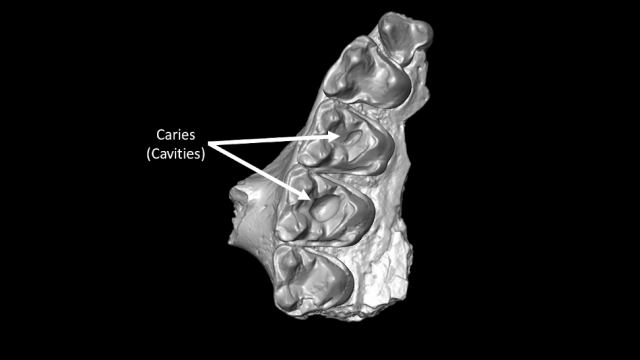New fossil evidence suggests mammals have been suffering from cavities for a very, very long time, and we can blame it on our timeless love of sugary foods.
Dental cavities have been detected in over 7% of fossils belonging to Microsyops latidens, a primate that lived during the Early Eocene some 54 million years ago, according to new research published today in Scientific Reports. The scientists, led by Keegan Selig from the University of Toronto Scarborough, say the cavities were likely caused by the consumption of sweet fruits and sugary foods, which is altogether relatable.
A cool thing about the new study is that the scientists were able to track the prevalence of cavities, sometimes referred to as caries, among M. latidens over time, allowing them to infer dietary changes across the same time period. What’s more, the methods used in the study can now be used to track similar dental problems and dietary habits/changes in other extinct species.
Not much is known about M. latidens (they have no living descendants), but they probably lived in trees and ate a combination of fruits and insects. Unlike primates living today, this animal “probably relied on its nose to sense the world compared to how much it relied on its vision,” Selig wrote in an email. The anthropologist embarked on this study to learn what types of food M. latidens was eating, and he thought dental cavities might offer some insights.
Cavities, whether they formed 54 million years ago or yesterday, are caused by mouth bacteria that eat sugars laced onto teeth. The bacteria spew out a highly acidic byproduct, which eats away at dental tissue, forming a hole, or cavity.
“We cannot be 100% certain that it was fruit that caused these cavities in M. latidens. Other factors such as the pH and biochemistry of the mouth might also produce cavities,” explained Selig. “But fruit, and specifically sugar, are major culprits in producing cavities, just like in our own mouths today.”
Fossil evidence for the study came from the Southern Bighorn Basin in Wyoming. The researchers amassed a sample of 1,030 individual dental fossils, such as teeth and jaw sections, spanning about 544,000 years of the Early Eocene. It’s now the “largest sample to date of fossil caries in a single extinct mammal species” and the “earliest known sample of dental caries in an extinct mammal,” as the researchers wrote in their study. A 12.5-million-year-old fossil from another extinct primate is believed to be the previous record holder for oldest known mammalian cavity.
Selig, along with anthropologist Mary Silcox, also at the University of Toronto Scarborough, visually analysed each of the 1,030 fossils, finding 77 of them to have cavities. That’s 7.48% of the samples.
“The most surprising thing was just how many of the individuals in our sample had cavities,” said Selig. “Compared to living primates, M. latidens had more cavities than we might expect.”
In terms of severity, the cavities ranged from very minor through to cavities that took up nearly half the surface of a tooth. Selig said it’s hard to know what effect this had on their health, “but having cavities, especially large ones, can lead to many health problems,” such as the loss of a tooth, infection, or discomfort while chewing. “None of these problems would be great for an animal,” he added.
Interestingly, the oldest and youngest fossils exhibited the fewest cavities compared to the rest. This likely means that “this species experienced a shift in their diet to include more fruit or other sugar rich-foods for a short period,” according to the study. “Our analysis, therefore, suggests that the diet of M. latidens fluctuated over time.” The reason for this likely had to do with shifting climates during the Early Eocene, which gave rise to different vegetation, and as a consequence, variable access to food.
Similar fossil sets could yield similar insights. Selig hopes his team’s findings “will lead to other researchers checking the fossils they study for cavities,” as these dental annoyances “can provide very useful information about the diet of an animal.”
A very cool study, but I suddenly have an overwhelming urge to brush my teeth.
More: Neanderthals took good care of their teeth, unlike some of us.
